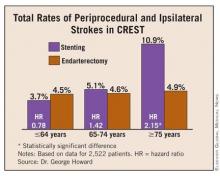The incidence of MI showed a much weaker age effect, and patients who underwent stenting had a reduced rate of MI at all ages, compared with those who had endarterectomy. In addition, in the endarterectomy arm, age had no significant effect on the MI rate. Among patients treated with endarterectomy, the incidence of MI was 1.6% in patients younger than 65 years and 3.2% in those aged 75 or older, differences that were not statistically significant, Dr. George Howard said.
Dr. Christopher J. Moran said that a physician who wants to prevent strokes in patients with carotid artery disease would have to "think long and hard before treating a woman with carotid stenting." In some cases, endarterectomy may not be an option: The woman may be a poor operative candidate, or may not be a good candidate for anesthesia. "But if a woman is a good operative candidate, she should be treated with endarterectomy," he said.
Conventional angiography or CT angiography lets an operator assess the size of a woman’s arteries, explained Dr. Moran, a professor of radiology and neurological surgery at Washington University, St. Louis, who performs carotid artery stenting but did not participate in CREST. The smallest self-expanding stents available for treating carotid disease are 5 mm in diameter, and because these are ideally oversized to the artery, the smallest diameter carotid that should be stented is 4 mm, he said. "Many women have carotids that are smaller than 4 mm, and in those cases you should definitely think twice about stenting."
The same considerations apply to patients who are 70-80 years old, Dr. Moran added. "If they are good operative candidates, they should undergo endarterectomy." The assessment of calcification and tortuosity in patients – factors that may be causing the worse outcomes in elderly patients who are treated with carotid stenting – might not be easy preoperatively. CT angiography may be able to identify these features. MR angiography will reveal tortuosity but not calcification. "The best assessment is by conventional angiography, although this is done much less frequently today than in the past. It is critical to initially assess a patient’s anatomy to determine whether he or she is a good candidate for stenting before starting the procedure," he concluded.
CREST received its primary funding from the U.S. National Institutes of Health, but received supplemental funding from Abbott Vascular Solutions, the company that markets the carotid stents and embolic protection devices used in the study. Dr. Virginia J. Howard said that she had no disclosures. Dr. George Howard said that he has been a consultant to Abbott. Dr. Brott had no disclosures. Dr. Moran said that he has been a speaker and a proctor for, and a consultant to, Codman and EV3 Inc.


